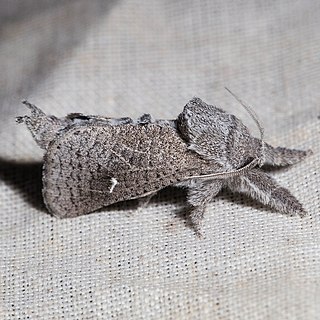Chrismania is a monotypic moth genus of the family Crambidae. Its only species, Chrismania pictipennalis, is found in North America, where it has been recorded from southern California and Arizona. Both the genus and species were first described by William Barnes and James Halliday McDunnough in 1914.
Fania connectus is a species of moth of the family Cossidae first described by William Barnes and James Halliday McDunnough in 1916. It is found in Texas in the United States.
Comadia is a genus of moths in the family Cossidae first described by William Barnes and James Halliday McDunnough in 1911.
Comadia albistrigata is a moth in the family Cossidae first described by William Barnes and James Halliday McDunnough in 1918. It is found in North America, where it has been recorded from Arizona, New Mexico and Texas.
The Hypoptinae are a subfamily of the family Cossidae.
Givira is a genus of moths in the family Cossidae.

Hypopta palmata is a moth in the family Cossidae first described by William Barnes and James Halliday McDunnough in 1910. It is found in North America, where it has been recorded from western Texas, Arizona, Nevada, California and Baja California Norte. The habitat consists of deserts and desert mountains.
Givira cleopatra is a moth in the family Cossidae first described by William Barnes and James Halliday McDunnough in 1912. It is found in North America, where it has been recorded from Arizona, California, Nevada and Utah.

Givira lotta, the pine carpenterworm moth, is a moth in the family Cossidae. The species was first described by William Barnes and James Halliday McDunnough in 1910. It is found in the United States, where it has been recorded from California, Arizona, New Mexico and Colorado. The habitat consists of pine forests.

Givira marga is a moth in the family Cossidae first described by William Barnes and James Halliday McDunnough in 1910. It is found in North America, where it has been recorded from California and Arizona.

Givira lucretia is a moth in the family Cossidae first described by William Barnes and James Halliday McDunnough in 1913. It is found in North America, where it has been recorded from Arizona, Texas and Wyoming.
Hamilcara is a monotypic moth genus in the family Cossidae. Its only species, Hamilcara atra, is found in North America, where it has been recorded from Arizona. The genus and species were first described by William Barnes and James Halliday McDunnough in 1910.
Psychonoctua gilensis is a moth in the family Cossidae first described by William Barnes and James Halliday McDunnough in 1910. It is found in North America, where it has been recorded from California and Arizona.
Evergestis triangulalis is a moth in the family Crambidae. It was described by William Barnes and James Halliday McDunnough in 1914. It is found in North America, where it has been recorded from Arizona, Nevada and New Mexico.
Evergestis vinctalis is a moth in the family Crambidae. It was described by William Barnes and James Halliday McDunnough in 1914. It is found in North America, where it has been recorded from Alberta, Arizona, British Columbia, California, Colorado, Kansas, Montana, Nevada, New Mexico, Texas and Wyoming.
Pyrausta sartoralis is a moth in the family Crambidae. It was described by William Barnes and James Halliday McDunnough in 1914. It is found in North America, where it has been recorded from California and Arizona.
Pyrausta zonalis is a moth in the family Crambidae. It was described by William Barnes and James Halliday McDunnough in 1918. It is found in North America, where it has been recorded from Texas, Arizona and California.
Cymbopteryx unilinealis is a moth in the family Crambidae. It was described by William Barnes and James Halliday McDunnough in 1918. It is found in North America, where it has been recorded from Arizona.
Heliothelopsis unicoloralis is a moth in the family Crambidae. It was described by William Barnes and James Halliday McDunnough in 1914. It is found in North America, where it has been recorded from Arizona.
Noctueliopsis virula is a moth in the family Crambidae. It was described by William Barnes and James Halliday McDunnough in 1918. It is found in North America, where it has been recorded from Arizona, California and Nevada.




